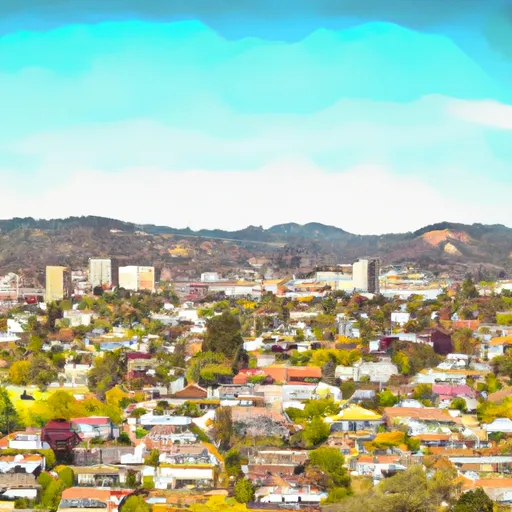-
 Snoflo Premium
Snoflo Premium
Get unlimited access to all our content
With no Ad interruptions! - Start Your Free Trial Login with existing account
Portola
Eden Index
Climate
6.7
•
Recreation
6.7
•
Community
2.7
•
Safeguard
5.7/10

Portola, California is a small town nestled in the Sierra Nevada Mountains. It experiences a Mediterranean climate, characterized by hot, dry summers and cool, wet winters. Summers in Portola are typically sunny with temperatures averaging in the mid-80s°F (29°C), while winters are cool with temperatures ranging from the mid-30s°F (2°C) to the mid-50s°F (13°C). The town receives an average annual rainfall of around 22 inches (56 cm), with the majority occurring during the winter months.
Portola is surrounded by natural beauty, with the Feather River and its tributaries flowing through the area. The hydrology constituents of Portola include rivers, streams, and numerous lakes, creating excellent opportunities for fishing, boating, and water sports. The region is also known for its stunning mountain landscapes, offering opportunities for hiking, camping, and wildlife observation.
In addition to its natural attractions, Portola boasts an array of outdoor recreation opportunities. Visitors can explore the nearby Plumas National Forest, which provides miles of trails for hiking and biking, as well as opportunities for hunting and off-roading. The town is also a gateway to the scenic Lakes Basin Recreation Area, known for its pristine alpine lakes, where visitors can enjoy fishing, swimming, canoeing, and picnicking. Overall, Portola offers a wealth of outdoor activities for nature enthusiasts in a picturesque mountain setting.
What is the Eden Index?
The Snoflo Eden Index serves as a comprehensive rating system for regions, evaluating their desirability through a holistic assessment of climate health, outdoor recreation opportunities, and natural disaster risk, acknowledging the profound impact of these factors on livability and well-being.
Climate Health Indicator (CHI): 6.7
Portola receives approximately
582mm of rain per year,
with humidity levels near 84%
and air temperatures averaging around
8°C.
Portola has a plant hardyness factor of
6, meaning
plants and agriculture in this region thrive during a short period during spring and early summer. Most
plants will die off during the colder winter months.
By considering the ideal temperature range, reliable water supplies, clean air, and stable seasonal rain or snowpacks, the Climate Health Indicator (CHI) underscores the significance of a healthy climate as the foundation for quality living.
A healthy climate is paramount for ensuring a high quality of life and livability in a region, fostering both physical well-being and environmental harmony. This can be characterized by ideal temperatures, reliable access to water supplies, clean air, and consistent seasonal rain or snowpacks.
Weather Forecast
Streamflow Conditions
Lower Sacramento
Area Rivers
Lower Sacramento
Snowpack Depths
Lower Sacramento
Reservoir Storage Capacity
Lower Sacramento
Groundwater Levels
Recreational Opportunity Index (ROI): 6.7
The Recreational Opportunity Index (ROI) recognizes the value of outdoor recreational options, such as parks, hiking trails, camping sites, and fishing spots, while acknowledging that climate plays a pivotal role in ensuring the comfort and consistency of these experiences.
Access to outdoor recreational opportunities, encompassing activities such as parks, hiking, camping, and fishing, is crucial for overall well-being, and the climate plays a pivotal role in enabling and enhancing these experiences, ensuring that individuals can engage in nature-based activities comfortably and consistently.
Camping Areas
| Campground | Campsites | Reservations | Toilets | Showers | Elevation |
|---|---|---|---|---|---|
| McMurray | None | 5,880 ft | |||
| Fir Top | 12 | 6,078 ft | |||
| Independence Lake | 20 | 6,957 ft | |||
| Carr Lake | 12 | 6,668 ft | |||
| Pass Creek | 30 | 6,137 ft | |||
| Lindsey Lake | 10 | 6,271 ft | |||
| Findley | 15 | 6,178 ft | |||
| Little Lasier Meadow | 12 | 6,484 ft | |||
| East Meadow | 46 | 6,130 ft | |||
| Grouse Ridge | 9 | 7,410 ft |
Nearby Fishing
Nearby Ski Areas
Catastrophe Safeguard Index (CSI):
The Catastrophe Safeguard Index (CSI) recognizes that natural disaster risk, encompassing floods, fires, hurricanes, and tornadoes, can drastically affect safety and the overall appeal of an area.
The level of natural disaster risk in a region significantly affects safety and the overall livability, with climate change amplifying these risks by potentially increasing the frequency and intensity of events like floods, fires, hurricanes, and tornadoes, thereby posing substantial challenges to community resilience and well-being.
Community Resilience Indicator (CRI): 2.7
The Community Resilience Indicator (CRI) recognizes that education, healthcare, and socioeconomics are crucial to the well-being of a region. The CRI acknowledges the profound impact of these elements on residents' overall quality of life. By evaluating educational resources, healthcare accessibility, and economic inclusivity, the index captures the essential aspects that contribute to a thriving community, fostering resident satisfaction, equity, and social cohesion.

